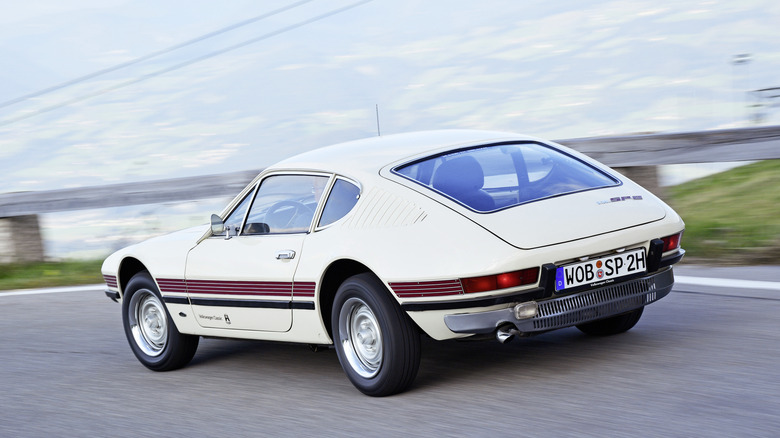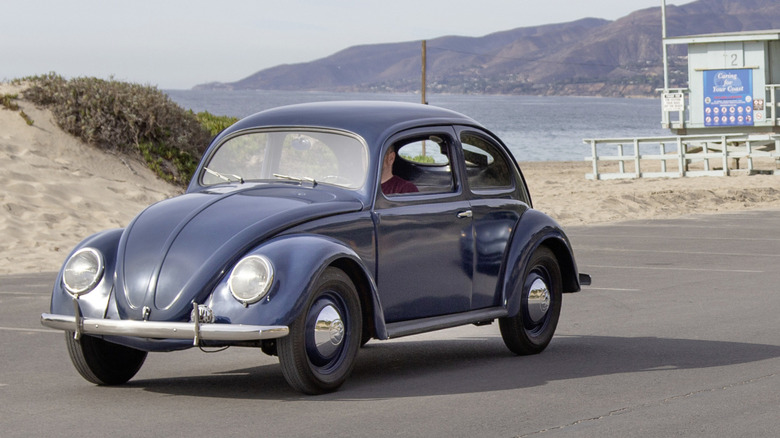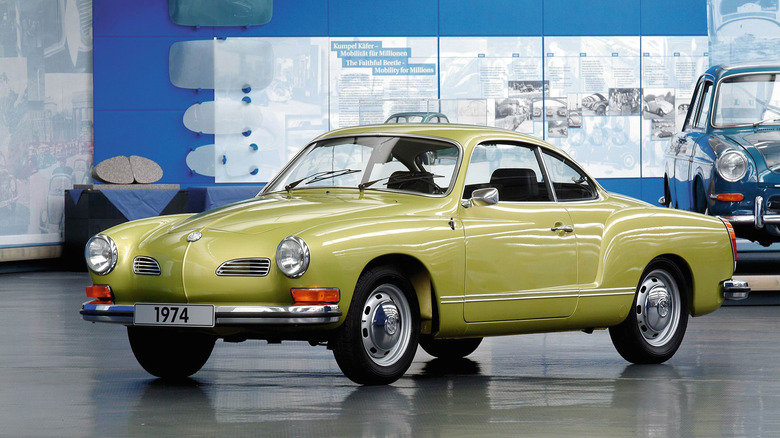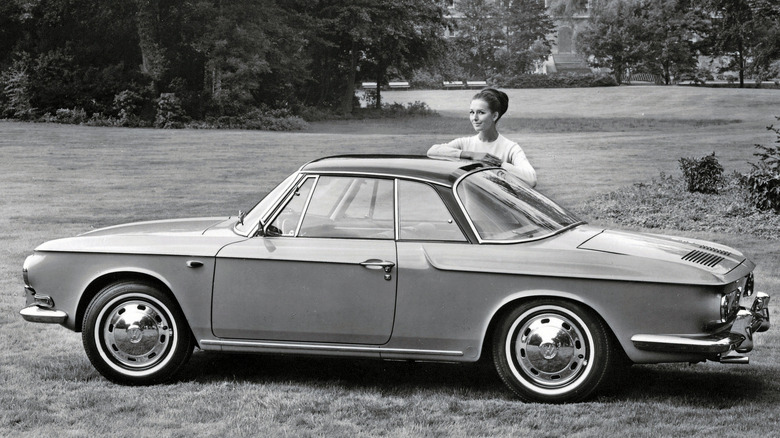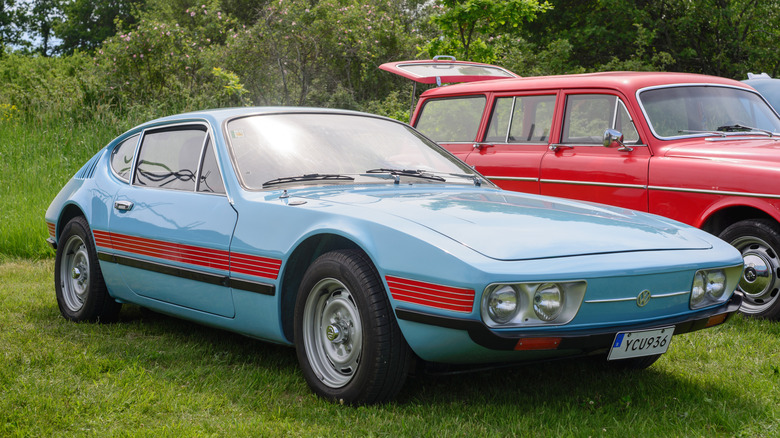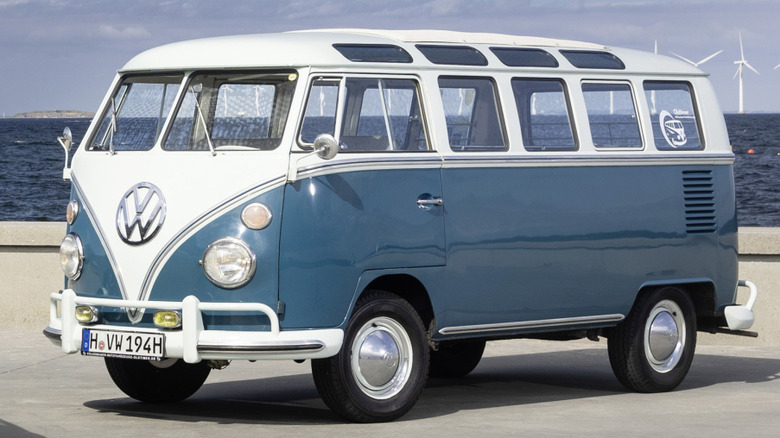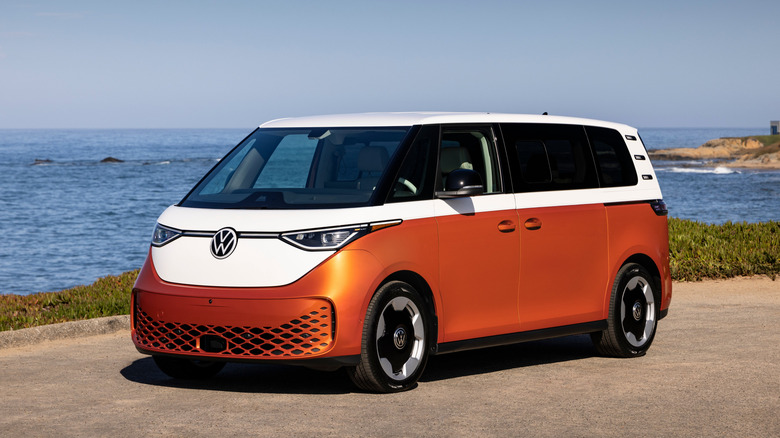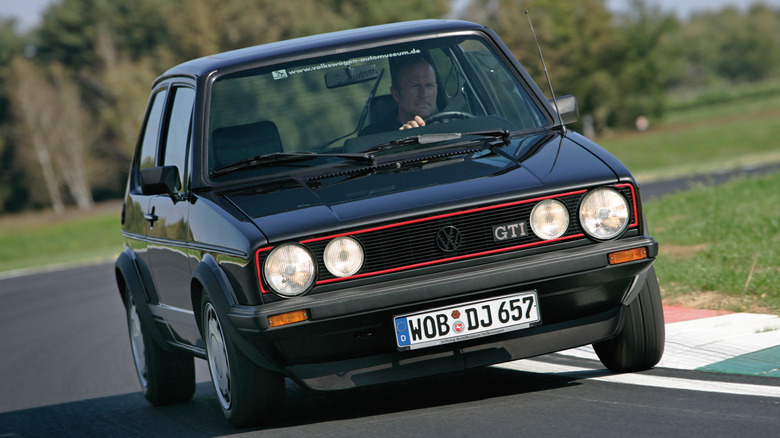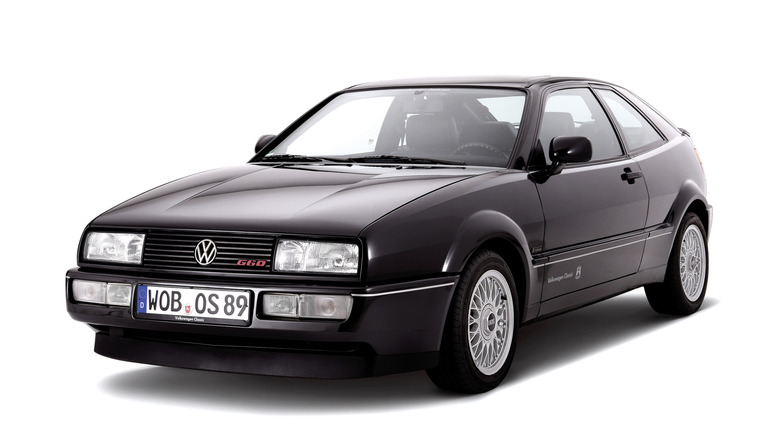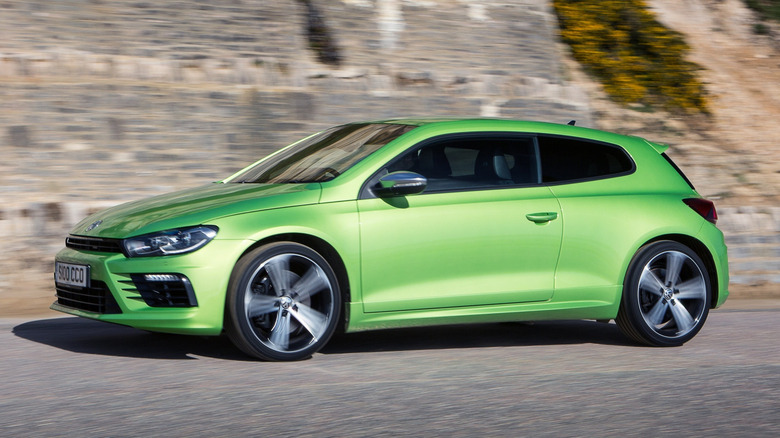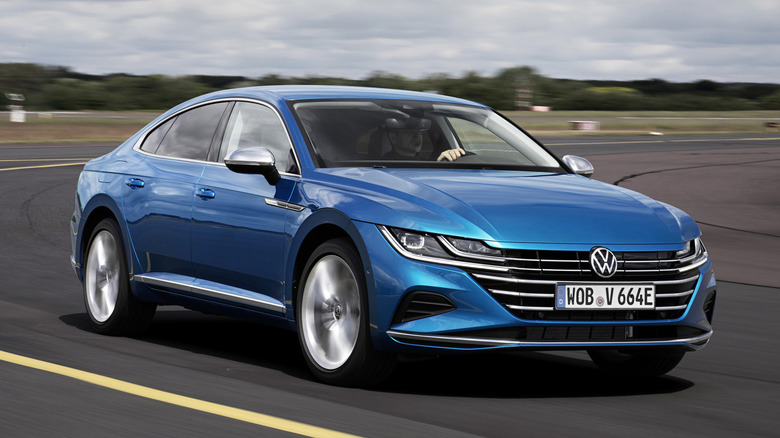10 Of The Best-Looking Volkswagens Of All Time
Volkswagen has been on a meteoric rise ever since it launched the Beetle in 1938. Today, it's one of the biggest automakers worldwide, with a vehicle in almost every segment. Moreover, the Wolfsburg-based automaker swallowed most of its rivals, with today's VW Group consisting of brands like Porsche, Bentley, Lamborghini, and Audi.
Still, Volkswagen's own models are the bread and butter of the company. Always developed and manufactured to the brand's stringent standards, VW's vehicles stand for German precision and engineering. Volkswagen also loves to keep to a certain standard when it comes to designing its cars, with each model following a particular design aesthetic. Even an automotive noob will recognize a VW from a mile away. Yet, this also means Volkswagen's designers have always played it safely. To some, the brand's vehicles have always looked dull, as if they lacked character. True, many of VW's cars can pass as in-game NPCs, and the brand has played it too safely on some occasions. These cars were still recognizable, though far from striking.
However, to say that Volkswagen has never produced visually appealing automobiles would be wrong, and we'll prove it by giving you some of the best-looking Volkswagens of all time. Buckle up, because this time-travel story will surprise you with jaw-dropping VWs you never knew existed, nestled alongside the brand's icons.
Volkswagen Beetle (1938 to 2003)
The original Volkswagen Beetle is easily the most iconic car model of all time. Developed during Nazi Germany, Hitler envisioned the Beetle as Germany's Ford Model T. The idea — to motorize the middle class with a "people's car" that was cheap, reliable, and fuel-efficient. The car ultimately succeeded, becoming one of the best-selling automobiles of all time. Curiously, the Beetle became the car of American counterculture during the 1960s, and it's easy to see why. The cheap Beetle resonated with the anti-consumerism folks and served as the symbol of the antiwar movement.
Still, it was arguably the cutesy design of the VW Beetle that made it so popular. Developed and designed by legendary German engineer Ferdinand Porsche, the Beetle looks like no other car from its era. The bubble-like, symmetrical teardrop shape, headlights built into the fenders, and smooth, flowing lines gave the Beetle originality. They made it more aerodynamic, too. Crucially, Ferdinand's prime achievement looked like it was sculpted by hand, with the long wheelbase and short overhangs giving it a dynamic appearance. No wonder, the Porsche 911 retains the same shape to this day. Oh, and yes, it looks like a bug. But a bug with a friendly smile and undeniable charm.
The Beetle's character wasn't only down to the design. The low-pitched, throaty buzz of the air-cooled engine oozed fun, light-hearted vibes, but it was also tactile in true German fashion. Beetle engines are also easy to maintain, which is one of the reasons why the Beetle is still worth buying today.
Volkswagen Type 14 Karmann Ghia (1955 to 1974)
Everybody knows the Beetle, but most folks don't know that it spanned multiple other models. Like the Karmann Ghia Type 14, for example, which is easily one of the best-looking Volkswagen cars ever produced. The swooping, sensual lines, built on top of a widened Beetle underpinnings, created an automotive design icon that still captivates audiences to this day.
Built by specialized German coachbuilder Karmann, the Ghia is a textbook example of sports car design. The designers experimented with fluid, yet muscular surfaces, giving the Ghia a more purposeful appearance. The swoopy surfaces are masterfully placed across the body, creating a car that looks like it moves even when stationary, true for the convertible and coupe. Unlike the Beetle, the Kharmann Ghia was also lower and had longer overhangs, giving it a sleeker look. Instead of lighthearted fun, the Type 14 oozed sophistication and class. Yet, Karmann also managed to inject just the right amount of Beetle-ness into the design to make it instantly recognizable.
You must be thinking that the engineers also had fun in other areas, but sadly, the Type 14 Karmann Ghia was never designed for performance. Initially, it had a 1.2-liter flat-four with 30 hp, mated to a four-speed manual. Acceleration was glacial, with 0-62 mph (0-100 km/h) taking 32.5 seconds. In 1971, Volkswagen finally gave the Karmann Ghia a more powerful engine; the new 1.6-liter unit made 49 hp, bringing the car to 62 mph in 16.4 seconds. Again, not fast, but that doesn't change the fact that the Volkswagen Karmann Ghia will look great in any garage.
Volkswagen Type 34 Karmann Ghia (1961 to 1969)
There is another, more obscure version of the Karmann Ghia — the Type 34. The reason it deserves its own place on this list is that it looks entirely different. Instead of the swooping, seductive lines of the original, the Type 34 was all about sleekness and understated elegance.
Karmann produced three different body styles — a classic coupe, convertible, and a fastback. Each had its own merits, but it's the coupe that stands out with its stunningly simple design. Low and wide, with long overhangs and symmetrical proportions, the Type 34 coupe has a timeless look that will never go out of fashion. Moreover, it had a recognizable, long rear "hood," which advertised the rear-engine configuration. The Type 34 Fastback is also an interesting design, as it looks almost like an angrier Mustang Mk1 from certain angles.
The Karmann Ghia Type 34 wasn't only a design exercise. It was meant as a higher-class car than the Type 14, and so it was initially offered with a 1.5-liter engine with 53 hp. In 1967, VW upgraded the Type 34 with a 1.6-liter unit good for 66 hp, alongside front disc brakes. Unfortunately, that wasn't enough for market success. VW built fewer than 43,000 units, compared to 445,000 Type 14s. Hardly surprising, as in Europe, the Type 34 cost $3,000 during the mid-1960s. For comparison, the Mustang launched at $2,368 with much better performance. Volkswagen never offered the Type 34 in America, but with the Mustang being its closest rival, it would've never succeeded, anyway.
Volkswagen SP2 (1972 to 1976)
For the fourth entry, we are going even deeper into obscurity land with the SP2. This forgotten two-seater sports car definitely deserves more attention, mainly because it looks so freaking good. It was not designed by Volkswagen Germany, but by the automaker's Brazilian subsidiary. Don't mistake 'carioca' VW for undesirable, though: the SP2 is captivating with its futuristic, extravagant design.
If it wasn't for the badge, most would've probably mistaken it for Italian exotica. The low, keen front end gives the SP2 purpose, with the four circular headlights looking ready for attack. The long, sloping hood connects perfectly to the squat side profile, which was made more playful with the teardrop-shape window lines. The fastback rear end gave the SP2 an unmistakable sporty appearance, with the side fins revealing the engine's position.
Although it looked like a supercar, the SP2 unfortunately didn't perform like one. At the back, VW Brazil equipped the sleek coupe with a 1.7-liter flat-four, good for 75 hp. That was enough for a 0-62 mph sprint of 16 seconds and a top speed of 100 mph. Still, it was an upgrade over the SP1, which had a 1.6-liter unit producing 65 hp. VW Brazil has built around 11,000 units, most of which stayed in the home country.
Volkswagen Type 2 Microbus/Transporter (1950 to 1975)
The Karmann Ghia models are easily the best-looking cars based on the Beetle, but none is as iconic as the Type 2 Microbus. Although it shared the wheelbase with the Beetle, the Microbus offered a vastly more capacious cabin. It was wider and longer, offering three seating rows for up to nine passengers, and additional space for cargo on the shelf over the rear engine. The Microbus was also a great traveling companion, particularly among the same counterculture folks that love the Beetle.
The large windows that spanned across the van's length allowed excellent views of the scenery, while the large body panels served as a blank canvas for artistic expression. It was also infinitely customizable, with many units being converted into campers. Acceleration was terrible — the Microbus arrived with only 25 hp, though it had a longer final drive for the highway. Still, it was the aerodynamic body, designed like a bullet train, that turned the original Microbus into an automotive icon.
The van retained the bug-like front end of the Beetle, but was sleeker overall, thanks to the longer body. The clean lines gave it elegance, but the star of the show was the two-tone exterior, combining a white roof with painted body panels. The Type 2's most recognizable feature was the front end, with the huge VW logo and paint-line crease that gave the front end more structure. The split windshield only added to the van's distinctive character.
Volkswagen ID. Buzz (2025)
The Volkswagen van evolution has brought us many capable vans, cementing VW's place as a leading player in the segment. Still, as far as design goes, one of the best generations is the recently launched ID. Buzz. An all-electric minivan, the ID. Buzz wants to attract eco-conscious people that value the added functionality and bold character of the van.
Volkswagen did a tremendous job honoring the original Type 2 Microbus, but without making it look retro. Instead, the ID. Buzz looks almost futuristic, taking the bullet train shape to new heights. It's sleek and elegant, thanks to the smoothed-out body — you'll find no sharp angle on the ID. Buzz. Even so, the two-tone combination gives it a playful, whimsical vibe, like the original Microbus.
Unfortunately, while the original Microbus was developed to be a cheap van for everyone, the ID. Buzz is for those with deeper pockets. The 2025 model starts at $61,545 — a steep price for an EV that provides 234 miles of range. Charging the battery from 10 to 80% via a DC fast charger also takes 30 minutes. Yup, this kind of defeats the ID. Buzz's long-distance credentials that the original was famous for.
Still, we think that the Volkswagen ID. Buzz is nostalgia worth paying for. It's super practical inside, with a lot of room for passengers and cargo. It's quick, too, particularly the dual-motor version with 335 hp, which sprints to 60 mph in just 5.5 seconds. Also, unlike the noisy original, the ID. Buzz's powertrain is smooth as butter, while the chassis is surprisingly balanced in the corners.
Volkswagen Golf/Rabbit GTI Mk1 (1976 to 1983)
The Golf GTI is hot hatch royalty. Affordable yet fun to drive, it gave the younger audience something to dream of. Not only that, but thanks to the hatchback shape and reasonably comfortable interior, the Golf GTI could serve as the only car for most people.
Sure, in today's horsepower currency, the Golf GTI Mk1 isn't particularly powerful. For its time, though, the 1.6-liter fuel-injected engine, good for 110 hp, gave enough oomph for a spirited 0-60 mph sprint of 9 seconds, and a top speed of 112 mph. The U.S. got the less potent, 90-hp Rabbit GTI due to emission regulations, but at least it had the 20-mm lowered suspension from the European model and stronger brakes. Crucially, the Golf GTI weighed only 1,852 pounds, making it agile and playful in the corners.
And then there is the way it looks. We already rated the Golf Mk1 as one of the best looking hatchbacks ever designed, owing to its short overhangs and perfectly proportioned body that was already a great basis for a hot hatch. Penned by Giorgetto Giugiaro, the original Golf is a quintessential example of how minimalism and restraint can create timeless design. Still, VW's designers made changes in the right places. Wider wheel arches. Lower stance. Red grille surround. Cool wheels. The Golf GTI looked fast even when standing still, radiating pocket rocket vibes from every angle. Sure, the American Rabbit GTI received the slightly duller square headlights, but it still looks good overall.
Volkswagen Corrado (1992 to 1995)
The Volkswagen Corrado is a classic example of VW's design trend during the 1990s, merging the angular styling from the Golf Mk2 and smoother, flowing lines of the Golf Mk3. Looking at it side-on, the Corrado has a dominant line that starts with the top of the hood, then gently slopes under the windows, and rises again to accentuate the fastback body. It's a simple line, looking like it was drawn with one hand movement, but very effective. It gives the Corrado an elegant, aerodynamic look.
Elsewhere, though, the Corrado is all about sharp, muscular creases. The cut off, striking front end looks bold and confident, with the thinner, rectangular headlights providing a dose of sleekness. The fastback rear design with a built-in spoiler is the cherry on top, giving a dynamic, sporty appearance. But it wasn't just for looks — the spoiler created real, useful downforce.
To truly appreciate the striking Corrado, though, you need to go for the VR6-powered models. The VR6 engine is more compact, thanks to the cylinder banks being positioned at a narrow 15° angle, sharing the same head. Thus, VW was able to cram one in the front-wheel-drive Corrado, making it an underrated German classic that deserves more attention. In Europe, the Corrado VR6 was equipped with a 2.9-liter engine with 187 hp, while the U.S. got a smaller 2.8-liter, good for 178 hp. Both were quick, though, and filled the cabin with a raspy sound that gave you the goosebumps.
Volkswagen Scirocco R (2009 to 2018)
For some, the last Scirocco was merely a redesigned Golf. A less practical one, at that. Yet, look a bit deeper, and it becomes apparent that the Scirocco deserved its place in VW's lineup. Sure, it utilized a front-wheel-drive platform, during a time when the Toyota GT86/Subaru BRZ twins attracted customers with their drift-ready rear-wheel-drive configuration. Heck, the high-performance Scirocco R version didn't even receive the all-wheel drive from the Golf R. But it didn't matter, because the Scirocco R scored highly where it mattered the most — the driving experience.
Yes, the front wheels were tasked with steering and dealing with up to 276 hp (2.0-liter turbo-four), but the lack of AWD also made the Scirocco R lighter than its Golf counterpart by 300 pounds. That's two average people. Accordingly, the Scirocco R only needed 5.5 seconds to reach 62 mph (six-speed DSG), but also felt more agile in the corners. Playful, even. Choose a variant with the six-speed manual, and grinning on a twisty road is guaranteed.
Even the harshest critics of the Scirocco R will agree that it's a stunner. Volkswagen managed to turn Golf's platform into a shooting brake lookalike, giving it almost an exotic car look. Low. Sleek. Pointy and purposeful at the front. Muscular at the back with wide haunches and prominent taillights. The Scirocco R truly is a sight to behold, particularly in person, where its low-slung and wide proportions leave you in awe. We are truly sad VW stopped producing the Scirocco in 2017.
Volkswagen Arteon (2017 to 2026)
The Volkswagen Arteon easily puts to shame the Camry and Accord with its elegant, yet sporty look. It looks more sophisticated. It sits lower to the ground and has a dynamic-looking fastback rear end. The front end is particularly striking, with wide chromed lines accentuating the grille and headlights neatly integrated in-between. It's truly a masterfully designed car, with proportions and surfaces that are particularly appealing in person. It won't look out of place next to a Mercedes-Benz CLS-Class. Or an Audi A7. Yet it cost tens of thousands of dollars less than those luxury machines.
Unfortunately, people today don't like class and sophistication. Well, at least that's what it looks like. Gargantuan, brash SUVs — that's what makes people happy. So, in early 2024, Volkswagen stopped selling the Arteon worldwide. On the bright side, the equally stunning Arteon Shooting Brake will remain in production until 2026.
But it's not just the design that makes us sad for Arteon's demise. Volkswagen equipped it with some potent engines, like a 2.0-liter turbo-four with 300 hp and 295 lb-ft of torque. Also, a quick-shifting seven-speed DSG, and available 4Motion AWD. Crucially, the Arteon drove like a dream. Apart from being impressed by the stylish appearance of the VW Arteon, colleague Chris Davies praised the refined powertrain and well-behaved adaptive chassis control. It's even spacious inside and has a practical trunk with a large opening, thanks to the rear liftgate.
